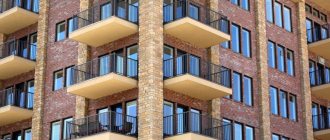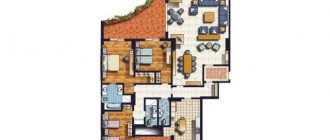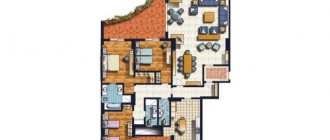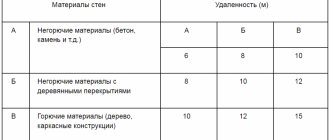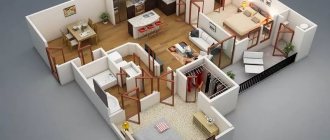Real estate
00:00, 11/23/2020 8 Plot: House in focus
What is included in the area of an individual house, how is the tax calculated and how to save on it
Photo: architekrym.ru
What is the difference between an attic and an attic, is the open terrace included in the total area of the house, why the number of storeys and the number of floors are different things, what replaced the technical data sheet and how to cheat when designing the location of the bathhouse - in the new article of the “House in Focus” project. Cadastral engineer Liliya Aleksandrovna Kupchikhina helps us figure out which elements are included in the total area of the house and which are not. Armed with this information, you can plan in advance where you will place a bathhouse or garage on the site, how you will distribute the residential floors, and whether you decide to build a separate gazebo instead of a terrace with a tea table.
How to determine
To find out what the living area is, you need to calculate the number of square meters of the entire space intended for living. This:
hall (guest room);
To obtain the quantity, each space is calculated separately. For example, in a one-room apartment this area is proportional to the parameters of the only room - the bedroom-living room, in a two-room apartment - the bedroom and living room.
See also: How to get a subsidy for the purchase of housing in 2021
Important!
Some people mistakenly attribute the kitchen or loggia to this space. But according to the Housing Code, this is a mistake. The dining area cannot be considered suitable for living, even if there is a bed there.
Non-residential area - the remaining space, including a corridor, kitchen, bathroom (bathtub and toilet), balcony, loggia. This includes storage rooms, hallways, and dressing rooms.
Everything is included The cost of repairs includes everything: work, materials, documents.
Without your participation After agreeing on the project, we only bother the owners when the repairs are completed.
The price is known in advance. The cost of repairs is fixed in the contract.
Fixed repair period Turnkey apartment renovation in 3.5 months. The term is fixed in the contract.
What is the general
Article 15 of the Housing Code states that all residential and ancillary premises are included in the total area. The exception is balconies, loggias, verandas and terraces: they are not included in the total area.
For example, if DDE purchases a one-room apartment with an area of 40 m2, of which 3 m2 are balconies, then according to the act they are taken into account with a reduction factor of 0.3, and the actual total area is 37.9 m2.
Calculation with a reduction factor
The reduction factor is used to calculate the total area for the purchase of housing under a house construction contract. This only applies to:
- Loggias - 0.5.
- Balconies - 0.3.
- Verandas - 1.0.
- Terraces - 0.3.
For example, if the area of residential and utility rooms is 50 m2, and the loggia is 5 m2, the total area of the apartment will be:
5 x 0.5 = 2.5 - taking into account the coefficient.
50 + 2.5 = 52.5 sq.m - total area in DDS.
What is included in the usable area of an apartment?
Usable area refers to the area of several rooms:
- Apartment: rooms, bedrooms, living room, office.
- By the way: bathroom, kitchen, balcony, etc.
What's included additionally
When calculating the indicator of the living space of an apartment, you need to take into account that it often includes a number of additional elements. These include:
Expert opinion
Ovadyuk Georgy
Partitions. According to SNiP (building codes and regulations), they cannot be skipped when determining the total footage suitable for living.
Niches. This includes only those that reach more than two meters in height.
Arches. Entered only if they meet the niche requirement above.
Stairs built indoors (for example, multi-level).
Heating stoves, other protruding elements.
To obtain accurate data without errors, owners often invite professional measurers. They carry out measurements taking into account building codes and the requirements of the Housing Code.
Why you need to know
The indicator of the total area of residential premises is used when:
calculating the amount of payment for utilities (if meters are not installed);
determining the owner’s share in the common property of an apartment building (the value of the share is proportional to the total number of common m2);
calculating the base for paying tax on land that is part of shared ownership;
establishing the required amount to pay residential tax and deduction (personal property tax);
calculating the cost of 1 square meter when buildings are recognized as unsafe and included in the program for relocating people.
This amount is necessary when determining the square footage allocated for ownership to social categories (disabled people, military) or participants in the subprogram “Providing housing for young families.” The figure will be needed when applying for a subsidy or determining how much the owner must pay for common house maintenance.
See also: Apartment rental agreement with a deposit: sample document completion
The calculation must be carried out when concluding a contract for the purchase and sale of real estate, a mortgage, or examining the living conditions of a minor by the relevant authorities.
Interesting fact!
The accepted property tax is determined by the size of the total, not residential footage. The fiscal service takes this information from the state register of property rights. This parameter is determined regardless of the redevelopment carried out, glazing work on a balcony or loggia.
How not to overpay when buying a home
Analyze the situation in advance. Before concluding a purchase and sale agreement, ask the seller whether extensions are included in the area of the apartment and on what basis. Often, unscrupulous sellers avoid a simple answer. The standard excuse is the inability to make a final estimate of the home's value due to ongoing construction. He may claim that there is no technical documentation on the site, but this is not true.
Analyze the findings of the BTI. After the house is built, the state commission receives the finished object. To rent out the property, the investor must know the exact number of square meters of the building. Local BTI specialists help with calculations and record them in documents with summary data tables. The data is broken down by category, including unheated rooms. Then BTI employees issue certificates for individual apartments with the mandatory application of a reduction factor.
Talk to the designer again. After an expert opinion, measurements and receipt of a certificate, the developer can provide the exact sale price of each apartment. If he refuses to include the reduction factor in his calculation, he should contact the judicial authorities for help. If you're right, home values will go down.
It happens that developers include their own coefficients in the regulations, for example, 0.8 or 0.4. This is illegal data that does not comply with SNiP. You have the right to hold the developer accountable and recover damages caused by fraud. However, if the developer decided to cover the losses and completely removed additional payments from the settlement, and the price per square meter increased, you will not be able to sue him. This is legal and enough to make an informed decision about buying an apartment from a particular developer.
How to measure
Information for all rooms is indicated in the technical passport for the apartment. Sometimes it happens that there are discrepancies in the actual measurements. For measurements, in addition to the technical passport, you will need a tape measure, paper, calculator and pencil. The actions are:
The apartment diagram is drawn on a sheet of paper. You also need to draw utility rooms - storage rooms, built-in wardrobes.
Using a tape measure, measure the length of the walls according to the level of the baseboard. The amounts are converted into meters and recorded on the diagram.
If there are curves or recesses in the configuration of the room, it is divided into separate figures, each with its own value indicated.
Width and length are multiplied.
Calculation coefficients
It is easy to determine the living area - just take the total value of square meters in all rooms that fit this definition. Additionally, certain coefficients specified in SNiPs are taken into account. Each room has its own.
If for some reason the dimensions of the loggia are calculated, a coefficient of 0.5 is applied. For balconies and terraces – 0.3. For buildings that have verandas, a coefficient of 1 is provided. The same figure is used when cold (unheated) storerooms are taken into account.
The calculations are easy, just add the meters of each room. True, this rule only applies if the shape of the room is correct (geometrically proportional square, rectangle). If not, you need to measure along the walls with a tape measure.
Interesting fact!
You need to measure the area of the walls using the inside of the baseboard. If you don’t want to do this, you can ask for an extract from the BTI. The exact values for all rooms are indicated there.
It is noteworthy that the coefficients for loggias and balconies are different, because they are different. The first has a ceiling with walls on the sides, and is located, as it were, inside the building. The balcony, on the contrary, extends beyond the boundaries of the house.
Do you need repairs?
We have already renovated more than 500 apartments, we will be happy to help you too
How to correctly calculate living space in the Republic of Belarus
Armed with a tape measure and an apartment plan, you need to measure each of the living rooms and everything that previously belonged to them. If there are niches and irregular geometry, it is better to divide the rooms into rectangles - this will make it easier to take measurements and add them up.
- Measurements are taken along the inside of the baseboard;
- In each room, measure the length and width and multiply them together;
- Add up all the resulting numbers.
Having received a firm figure, you will reliably know the answer to the question of whether you can qualify for improved conditions. Based on the square footage of the living space, its market value and rental payment are often calculated.
Housing rationing in Belarus
The norm of living space per person is a concept fixed at the legislative level. And it also allows you to accurately determine the living conditions of the family. If the living space is less than required, the family can apply for improved conditions and receive subsidies from the state. To be fair, it should be said that “extra” square meters in Belarus are not taxed and are not taken away from wealthy people.
However, the norm is a floating concept. It largely depends on the region of residence of a person. So, their current meaning is:
- In Minsk, a person must have at least 10 square meters of living space;
- In other cities - 15 squares;
- In dormitories, regardless of their location, 6 meters are allocated for each family member. While waiting for replenishment, you can apply to expand your living space.
If you have carefully calculated the living space, divided it by the number of family members and received a result that is less than the standards established by the state, then you have every right to apply for a preferential loan or subsidy for the purchase of a new, more spacious home.
How is it determined for a new building?
When the future owner buys housing in a house under construction, a share participation agreement is concluded - a document that states the terms of cooperation, indicates design solutions, and the layout of all premises. When the living area of a new building is calculated, measurements and calculations are made taking into account reducing factors. The agreement clearly regulates all indicators.
The development company indicates which footage is taken as a basis - general, or based on space suitable for living. When the latter is the main value, the cost of 1 m2 of housing increases, and vice versa, it decreases if the first is considered the main one.
When carrying out a comprehensive renovation, the location and total amount of living space is always taken into account. This number is important for determining the required number of pipes, communications, and space for installing the air conditioner. Experienced specialists will help you calculate everything correctly.
Expert opinion
Ovadyuk Georgy
If you do such a complex task yourself, the results may not be ideal - for example, the ventilation will not be of sufficient quality.
Sometimes, during redevelopment, the living space indicator changes. This can happen after the living room merges with part of the corridor (this is often done to expand the first). A balcony or loggia can become suitable for living if the wall between it and the room is demolished, heating and glazing are installed.
Any changes of this type must be registered and included in the registration certificate.
See also: Mortgage for a garage and parking space in Sberbank in 2021
How to find out what is included in the living space of a private house, and how can it be calculated?
When choosing a private house for purchase or when designing before construction, one of the most important parameters is its area. However, often the seller, buyer and developer speak different languages, understanding the area of the house as completely different concepts.
There are several terms that are used to determine the size of a building: built-up area, gross area and living area, with the meanings of the terms varying greatly. What is included in the living space of a private house?
Basic terms in construction
Many people have completely different concepts about the area of a private house
When designing a building, the designer and developer use 4 basic concepts to calculate:
- Area of premises. This is a calculation of the size of the room, determined by the distance between the walls without taking into account the baseboards. If a stove or fireplace is installed in a private house, its dimensions are excluded from the area of the premises during calculations.
- The total area of the building is the total area of all residential and non-residential premises, which includes rooms, kitchen, vestibule, corridors, hallway and built-in closets. Previously, when calculating the total area, verandas, terraces and outdoor areas, balconies and loggias were taken into account, but now this rule has ceased to apply.
- Living area is the total size of living rooms; in documents they are taken into account as rooms intended for permanent residence of people. These are the kitchen, living room, bedroom, children's room, study, and this concept also includes dressing rooms.
- Usable area (in foreign standards it is designated as “used”). This is the total area of all premises; the area of stairs and staircases, as well as elevator shafts and ramps is excluded from this value.
Also during construction, the concept of “building area” is very important: according to the law, it should not exceed 30% of the total area of the site. This value includes the total area of the horizontal section of the building drawn at the level of the basement.
In this case, this value includes the area of the porch, terrace or veranda, but does not include the size of the balcony on the second floor if it does not have additional load-bearing pillars.
Knowledge of all these concepts allows you to understand what size a house should be and determine the requirements for the developer and designer. In addition, the total and living area are indicated in advertisements when searching for a buyer for a house.
Data on the size of the total and living area of the building are entered into the technical passport of the residential property and the certificate of registration of the property.
Everything inside the walls is included in the area
Generally speaking, the area of your home is measured by the exterior walls. A cadastral engineer arriving at the site measures the house from the outside using satellite geodetic measurements. Essentially, the entire outline of the building from the outside is measured - and everything inside it will be taxed. So, for example, if you plan to build a house with half-meter thick partitions between the kitchen and living room, get ready for the fact that the area measured by the cadastral engineer will not match what you measure with a tape measure inside the building.
The area of your home on which property taxes will be calculated will include the total area of all floors, including:
- thickness of walls and partitions;
- area of staircase steps and interstairwells;
- area of storage rooms, loggias, verandas, terraces, bay windows, etc.;
- area of the ground floor, basement or attic;
- the area of the bathhouse and garage in the event that, apart from the house, they cannot perform their functions (for example, they have a common wall with the house).
The area of your home on which your property taxes will be calculated will include the total area of all floors.
Photo tochmash-ural.ru Cadastral engineer Liliya Kupchikhina warns:
— Often, when preparing documents, when the final area of the house is determined, people are surprised: why did it turn out to be so much? After all, they planned it completely differently. But the fact is that in the minds of many people there are still rules from those times when the area was still divided into residential and non-residential (for example, the corridor and bathroom were considered non-residential area, and the living room and children's room were considered residential). But now, according to the law, there is no such division. The area of your home is calculated in its entirety and is determined as the sum of the floor areas. And the floor area is calculated from the outer walls from the inside along the perimeter.
It turns out that no matter how thick the walls and partitions are from the inside, all this will not reduce the area of your home in any way. An interesting nuance: compared to the previously used calculation method, the area of the house is now becoming larger. This means that citizens pay more taxes on registered real estate.
What is the difference between common and living space?
The living area of a private house includes the area of living rooms
The concept of the total area of the house is taken into account when calculating the norm that should fall on each person living in a given room. If it does not meet the standard, then the person has the right to get on the waiting list to improve their living conditions.
In addition, this parameter is taken into account when calculating the cost of heating if a heat meter is not installed in the apartment or house. In this case, you have to pay for all heated rooms in the building.
The living area must be indicated in advertisements when selling, since this parameter allows you to estimate the actual size of the living space. So in a large house a spacious hallway or vestibule can be equipped, but the rooms themselves will be small and cramped. The decision must be made not only after evaluating the documents, but also after a visual inspection of the house.
If the management company incorrectly calculates the cost of heating due to the total area incorrectly indicated in the documents, it is necessary to reissue the technical passport, after which the corresponding changes are made to the cadastral passport and certificate of ownership. After this, the management company will have to recalculate.
Housing accounting rate
The accounting standard is established to determine the provision of sufficient space to residents for a comfortable life (Article 50 of the Law of the Russian Federation “On Housing and Communal Services”). Therefore, when establishing an accounting standard, they focus on living space.
Example: The total area of the apartment is 70 m2, which seems more than enough for a comfortable stay for an average family. However, due to the poor layout, most of the apartment is dedicated to the kitchen, bathroom, toilet and utility room. As a result, the living area of the rooms is only 40 square meters, which may not be enough. It is the living space that is taken into account when checking the calculation.
Nuances of assessing the total and living space
Attic area is a controversial issue when assessing housing
When calculating the total and living space, the buyer and seller or the customer and the developer often have disagreements, since several important nuances are not taken into account:
- If the building has niches whose height is less than 2 m, they cannot be taken into account as part of the living area of the room.
- If the area of the space under the flight of stairs is no more than one and a half meters, it will also not be taken into account when assessing the size of the house.
It is especially difficult to calculate the dimensions of the living space of the attic floor or the attic used. In this case, the main parameter for calculation becomes the roof slope. If the roof slope is 27 degrees, the total living area includes only a part of the room with a height of 1.5 meters to the roof.
Each future homeowner needs to learn how to independently measure the total and living area in order to check the compliance of the finished building with the data stated in the project. To do this, the room must be cleared of furniture, and then measure the length and width of the room. The resulting dimensions are multiplied, thus measuring the size of each room in the house.
An accurate calculation of the total and living area is necessary when designing a future home and during subsequent acceptance of the building after completion of construction. When selling, this is one of the key parameters that directly affects the assessment of the final cost of the building.
This video will tell you how to correctly calculate the area of a room:
Calculation rules
We have understood the concepts and basic components of housing. Now let's figure out how to calculate living space. This aspect is one of the most important, as it has a key impact on the value of the property. It is explained above which premises fall under the definition of residential, so there should be no problems with the calculations. Everything is very simple. You need to determine the area of each room and add up the results.
You can additionally learn about the area of the apartment from the registration certificate, which is stored in the BTI. To receive it, you must come to a separate office, providing the following package of documents:
- passport;
- Confirmation of ownership of the apartment;
- application in the prescribed form;
- receipt for payment of state duty.
If the apartment does not have a technical certificate or has undergone redevelopment, in this case you should call a specialist who will take all measurements and draw up the relevant documentation. You can also use the services of independent organizations that specialize in calculating the living space of a house, but you will have to pay for their services. But there is also a positive side, namely the speed of work. Everything can be arranged in a few days, but waiting for a specialist from BTI can take several months.
Residential and non-residential premises: what are they and for what purposes are they suitable? Let's deal with it wisely
- The square footage of the apartment includes the area of all residential and utility rooms included in it, together with balconies, unheated storage rooms, loggias, verandas, and vestibules. Utility rooms are combined or separate bathrooms, bathrooms, kitchen spaces, corridors, built-in wardrobes.
- For a residential building, this indicator is the sum of the areas of individual apartments.
- The total area of the dwelling is equal to the sum of all its areas (residential and auxiliary use) with the exception of the space on the balcony, terrace, veranda or loggia according to the Housing Code of Russia - Article 15, paragraph 5). The cadastral passport indicates this type of property characteristics. It is also a characteristic of the object entered into the register of rights.
- The total area indicator for a building is calculated by summing similar values for all apartments.
- The area of living rooms in an apartment constitutes its living area, and the apartment-by-apartment values of this value for the entire house constitute its living area.
What premises are considered
This period is regulated by the developed Instructions for accounting of housing stock in Russia. It is determined by the sum of square meters of living space and premises and directly affects the cost of apartments in Moscow. We are talking only about residential premises:
- dormitory;
- dining room;
- living room;
- Personal Area;
- restroom.
The living area does not include such premises as: kitchen, bathroom, halls, cabinets, wardrobes, built-in wardrobes, balconies, loggias and other premises that are not residential premises.
Also read: How to get a cash loan
Which rooms are considered residential and non-residential premises in a private house
2. Residential premises are recognized as isolated premises, which are real estate and are suitable for permanent residence of citizens (meets established sanitary and technical rules and regulations, other legal requirements (hereinafter referred to as requirements)).
See also: Providing Housing to Veterans of Combat Operations in Chechnya After 2005
Which rooms in the house are residential?
In accordance with Article 15 of the RF Housing Code, the total area of residential premises includes “the area of auxiliary premises intended to satisfy citizens’ household and other needs related to their residence in residential premises,” but does not include “balconies, loggias, verandas and terraces.”
An apartment is recognized as a structurally separate room in an apartment building, providing direct access to the common areas in such a house and consisting of one or more rooms, as well as auxiliary premises intended to satisfy citizens' household and other needs related to their residence in such a separate apartment. indoors. In practice, an apartment is considered a separate living space intended and used for living, which has a separate exit to the street (to the courtyard, staircase or common corridor) and a separate kitchen * (57). The absence of functional parts (areas, volumes) of other apartments (common areas) within its boundaries is also referred to as characteristics of an apartment * (58).
What is not included in the area of the house?
According to Order P/0393 of the Federal Service for State Registration, Cadastre and Cartography dated October 21, 2021, which will come into force on January 1, 2021, the following areas will not be included in the total area of the house:
- underground for ventilation and technical underground (the space between the foundation and floor coverings);
- unused and technical attic (the space between the ceiling of the upper floor and the roof);
- vestibule;
- porch;
- external open staircase and ramp;
- non-apartment utilities with vertical (in channels, shafts) and horizontal (in interfloor space) wiring;
- area under the heating stove (or fireplace). In this case, the stove or fireplace should not be a decorative element - they should carry a direct functional load.
For reference: a vestibule in the appendix to SNiP 2.08.01-89 is defined as a passage space between doors that serves to protect against the penetration of cold air, smoke and odors when entering a building, staircase or other premises.
Be careful: an attic and an attic are not the same thing, so when planning a house project, immediately decide whether the space between the top floor and the roof will be habitable. The attic, firstly, is considered a separate floor (do not forget that the maximum permitted number of storeys in an individual house is 3), and secondly, it is included in the total area of the residential building. The attic is not included in the area and is not used for living: many owners arrange it, for example, as a space for storing something useful or lay technological lines along it. What you choose - you need to decide before construction begins.
Liliya Kupchikhina talks about how to plan a bathhouse or garage so that they are not included in the area of the house:
— A constant question is whether a bathhouse is included in the area of the house. Yes, it turns on if the house cannot be separated from it without affecting its functionality. It also clarifies whether the garage is included in the area of the house. If, for example, a bathhouse or garage has at least one wall in common with the house and stands on the same foundation, it means that they form a single whole with the house and are included in its total area. If you don't want to include them in your taxable area, it makes sense to build them as free-standing properties with their own four walls.
Norms and procedures for individual housing construction, rules for individual housing construction – Sale of land plots without a contract
- Load-bearing and enclosing structures of residential premises must be in working condition and ensure the safe stay of citizens and the safety of engineering equipment
- Residential premises must be arranged and equipped in such a way as to prevent the risk of injury to residents when moving in and around the residential premises.
- Residential premises must be provided with engineering systems (electric lighting, drinking and hot water supply, drainage, heating and ventilation, and in gasified areas also gas supply). In settlements without centralized utility networks, one- and two-story buildings may not have running water or sewerage latrines.
- Engineering systems, equipment and mechanisms located in residential premises must comply with sanitary and epidemiological safety requirements. It is not allowed to combine ventilation ducts of kitchens and sanitary facilities (auxiliary premises) with living rooms.
- Engineering systems must be placed and installed in accordance with the safety requirements established in current regulations and the instructions of equipment manufacturers.
- External enclosing structures of residential premises must have thermal insulation that ensures in the cold season a relative humidity of no more than 60 percent, a temperature of heated premises of at least +18 degrees Celsius, as well as insulation from the penetration of cold air, vapor barrier, absence of moisture condensation on internal surfaces and preventing accumulation of excess moisture in residential building structures.
- Residential premises must be protected from the penetration of rain, melt and ground water and possible domestic water leaks from engineering systems using structural means and technical devices.
- The permissible height of a residential building in use must correspond to the class of the building's structural fire hazard and the degree of its fire resistance established in the current regulations.
- The space-planning solution for residential premises, the minimum area of rooms and premises for auxiliary use intended to satisfy citizens' household and other needs related to their residence in residential premises (except for the hallway and corridor), must ensure the possibility of placing the necessary set of furniture and functional equipment, taking into account ergonomic requirements.
- The height (from floor to ceiling) of the rooms and kitchen (kitchen-dining room) in climatic regions IA, IB, IG, ID and IVa must be at least 2.7 m, and in other climatic regions - at least 2.5 m. Height corridors, halls, hallways, mezzanines should be at least 2.1 m.
- The floor level of the living space located on the ground floor must be higher than the planning level of the ground.
- Placing a restroom, bathroom (shower) and kitchen above the rooms is not allowed.
- Rooms and kitchens in living areas should have direct natural light.
- Other auxiliary premises intended to satisfy citizens’ household and other needs may not have natural lighting.
- In residential premises, permissible levels of vibration from internal and external sources during the day and at night must correspond to the values established in current regulatory legal acts. (Resolution of the Government of the Russian Federation dated January 28, 2006 No. 47 “On approval of the Regulations on recognizing premises as residential premises, residential premises unsuitable for habitation and an apartment building as unsafe and subject to demolition or reconstruction”).
How to calculate, clarify or reduce the area of a house
One of the most important dimensions of premises is their area. The exact area of the house (or apartment, as well as any other premises) must be known in order to correctly evaluate the house when selling or renting; The ability to calculate the area of a house is also necessary when constructing or adding an extension to some part of it. In other words, this knowledge will always be useful. But they are most relevant today, when the country is preparing to transition to taxation of capital construction projects based on their cadastral value. And, as you know, the cadastral value depends specifically on the area of the living space. When it comes to regular payments, many property owners consider it advisable to clarify: is the area of the house indicated in their documents correctly? Is there any error? In addition, some are looking for a way to reduce this amount one way or another in order to save on taxes. We will consider all the identified issues by contacting a specialist. As noted in the cadastral chamber, in connection with the transition to a new method of taxation, owners of residential premises increasingly want to clarify information about the area of the premises they own and make changes to the state real estate cadastre. Often, changes in area are not associated with redevelopment, major or current repairs, but come down to clarifying the size of the premises, since quite often there are cases of incorrect calculation of area as a result of previously made mistakes. So, to establish the exact area of your real estate, you can go in two ways: 1 - try to calculate the figure yourself and then compare the results obtained as a result of calculations with the information in the documents; 2 - contact a cadastral engineer - and in this case you can not only be guaranteed to clarify the area, but also at the same time make corrections to the documentation, if necessary. But first, let’s try to figure out what the area of a house is, what are the legal requirements regarding its calculation. Indeed, in practice there are many varieties of this indicator: this is the building area, and usable area, and residential area, etc. The total area of a house is the sum of the areas of its residential and non-residential premises. Let's consider a case when it is necessary to clarify the area of a house to correct information in the state real estate cadastre. To answer the question of how the area of a residential premises is determined, let us turn to the current legislation. Today, in accordance with Part 10 of Article 41 of the Federal Law of July 24, 2007 No. 221-FZ “On the State Real Estate Cadastre,” the requirements for determining the area of buildings and premises are established by the regulatory body in the field of cadastral relations. Such a body is the Ministry of Economic Development of the Russian Federation.
In addition, on September 30, 2011, the Ministry of Economic Development of Russia approved the Requirements for determining the area of a building or premises by its order No. 531. According to the new Requirements for determining the area, the total area of a residential premises (residential building) consists of the sum of the area of all parts of such premises (residential building), including the area of auxiliary premises intended to satisfy citizens' household and other needs related to their residence in residential premises, with the exception of balconies, loggias, verandas and terraces . The area of auxiliary premises includes the area of kitchens, corridors, baths, toilets, built-in closets, storage rooms, as well as the area occupied by the internal staircase.
It should be noted that the above approach to calculating the total area of residential premises corresponds to the rule established in Part 5 of Article 15 of the Housing Code of the Russian Federation, according to which “the total area of residential premises consists of the sum of the area of all parts of such premises, including the area of auxiliary premises intended for satisfaction by citizens of household and other needs related to their living in residential premises, with the exception of balconies, loggias, verandas and terraces.”
The Real Estate Department of the Russian Ministry of Economic Development also contributed to the definitions. According to this department, auxiliary premises should also include boiler rooms, workshops and other premises located on the ground and basement floors, as well as other premises intended to satisfy citizens’ household and other needs; This also includes extensions such as greenhouses, swimming pools, ironing rooms, winter gardens, etc.
It would seem that any buildings are included in the total area of the living space. However, there are still exceptions: the Real Estate Department of the Russian Ministry of Economic Development specifically clarifies that the area of the garage and vestibule should not be included in this value.
When determining the total area of the house, it is also necessary to answer the question: is the extension a veranda or is it a room for auxiliary use and, accordingly, should be included in the total area of the residential building? This issue was commented on by specialists from the cadastral chamber.
According to them, a veranda is a glazed, unheated room attached to or built into a building. This can only be determined unambiguously as a result of a full-scale examination of the residential premises. Thus, whether part of the house is a veranda or not is determined by the cadastral engineer under his responsibility.
Thus, the criterion for inclusion or non-inclusion of certain premises in the total area of a residential building is not the sign of their heating or unheating, which, before the entry into force of the current Cadastre Law, guided technical inventory organizations, but the type and purpose of use of a particular premises in a given residential building home.
Now let's try to figure out whether it is possible to reduce the area of the house in order to reduce taxation.
For this purpose, cadastral authorities in various regions of the country have recently quite often received applications from owners of residential buildings to take into account changes in information about the total area of a residential building. People bring with them technical plans prepared by cadastral engineers, in which the total area of the building is not determined in accordance with the norms of current legislation. For example, they often try to exclude from the total area of a residential building the area of auxiliary premises intended to satisfy citizens’ household and other needs related to their residence in residential premises. It is clear that in this way the owners of residential premises are ultimately trying to reduce the cadastral value of a given house.
But it should be remembered that it is possible to exclude any areas from the total area of a residential premises, without carrying out work on the reconstruction of this house, if previously this area was mistakenly included in the area of a balcony, loggia, veranda or terrace, or areas premises not intended to satisfy citizens' household and other needs related to their residence in residential premises, for example, the area of a garage, experts note.
In general, we can summarize the following.
When preparing a technical plan for a residential premises, a cadastral engineer must independently carry out the necessary measurements to determine the area of the premises, while being guided by the Requirements for determining the area. If, during cadastral work, a cadastral engineer reveals a discrepancy between the area of a room or building specified in the documents on the basis of which the technical plan is being prepared, this information is reflected in a special section of the technical plan called the “Conclusion of the cadastral engineer.” It also contains the cadastral engineer’s proposals for eliminating identified errors, including the results of the necessary measurements and calculations.
And finally, in line with the conversation about how to calculate the area of a house, it is impossible not to at least briefly mention the case when it is necessary to calculate the area of the future house - at the beginning of its construction. Suppose you are doing construction yourself, and you also decide to determine the area of the house yourself. A few practical tips and recommendations will be useful. To begin with, you should take into account and provide for all the needs of the future residents of this house. The second important factor when calculating the area of a house is taking into account the predicted heating costs (usually 50-60 W are required to provide heat per square meter of house area). The total area of the house is used when designing a house to roughly estimate its future value, so this parameter is important during construction. However, it is important not to forget that two houses with the same area may differ in price for various reasons: depending on the layout of the premises, building materials, types of finishing, etc. The total area of a house is the sum of the areas of all the premises included in it: both residential and non-residential. In other words, this includes both rooms in which people live directly - bedroom, nursery, living room, office, etc., as well as rooms of auxiliary value. The set of non-residential premises includes built-in wardrobes, balconies, verandas, utility rooms, staircases, etc. For the calculation, so-called reduction factors are used (for example, for a loggia it is 0.5, for a balcony - 0.3, for a veranda - 1). Moreover, if it is planned to install a stove in a future house, then the area that the stove (or fireplace) will occupy is not included in the total area of the house. Let's assume that you have taken all this into account and provided for it, and the plan for your future home is ready. Now we have to do the calculations. How to calculate the area of a house? Technically, measurements are taken at floor level, minus the baseboard, but taking into account the interior finishing coatings. The building area of the house is calculated as the horizontal sectional area along the outer contour, including protruding parts (stairs, terraces, etc.). This value is taken into account at the initial stage of designing the future house and allows us to estimate the ratio of the sizes of the entire plot and its part occupied by the house. In addition, at this stage of the project, an estimate for the future foundation is laid down, and this parameter is taken into account in conjunction with the individual geological data of the area in which the site is located. We hope this material was useful to you.
